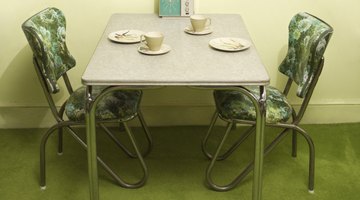How to Reupholster Vinyl Chairs
One way to jazz up a set of vinyl chairs in need of a little TLC, such as a retro dinette set, is reupholstering them. Upholstering with vinyl is much the same as upholstering with other fabrics. Vinyl is usually a little thicker, which means you'll have to take extra care when stapling corners.

Upholstery supply shops sell vinyl in modern color schemes and in styles more popular in other eras. That's ideal for working with vintage or retro furniture.
Things You Will Need
- Screwdriver
- Adjustable wrench
- Staple remover
- Vinyl several inches larger than seat
- Permanent marker
- Scissors
- Batting
- Staple gun
Tip
If the chair seat appears to be permanently affixed to the frame, study the vinyl's means of attachment before removing the old vinyl. Replace with the new in the same fashion the old was attached. Inspect the chair carefully before taking it apart to learn the tricks and techniques used to upholster it originally, such as the specific folds and tucks along the bottom of the seat. If the vinyl is too firm or unwieldy to successfully fold and staple corners, apply heat from a hair dryer set to low or medium to soften it slightly.
Warning
Wear eye protection when you're working with staples, to avoid injury.
-
Flip the chair upside down to determine how the seat is held in place. Remove the seat from the frame by removing the screws or bolts holding it on, using a screwdriver or an adjustable wrench. In some cases, the seat may simply pop out by pushing it from the bottom.
-
Remove any other vinyl-covered areas from the chair using the appropriate tool, as in Step 1.
-
Remove the staples holding the vinyl onto the seat or seat back, using a staple remover. Pull the old vinyl and batting off the chair, keeping the vinyl intact to use as a template.
-
Place the new vinyl face down on a clean work surface. Flatten and smooth the old vinyl over the new. Trace the old vinyl shape onto the back of the new vinyl with a marker. Set the old vinyl aside. Cut out the new vinyl along the traced lines using scissors.
-
Smooth a piece of batting onto the work surface. Set the new vinyl atop the batting, then cut the batting to the same size as the material, using scissors.
-
Flip the batting and vinyl so the vinyl is face down on the work surface with the batting atop it, lined up evenly.
-
Place the chair seat upside down atop the batting. The old foam, if the chair seat contains foam, will touch the batting.
-
Wrap one side of the batting and vinyl over its respective edge of the chair. Staple it in place every 2 inches or so. Repeat the process with the vinyl and batting on the opposite side of the chair.
-
Grab the batting and vinyl together on one of the remaining two sides of the seat, wrapping them over the bottom of the seat and stapling them in place. Repeat the process with the remaining side, pulling the batting and vinyl as tightly as possible before stapling. Staple it in place every 2 inches or so.
-
Fold and tuck the batting and vinyl along one corner, as if you're wrapping a package, and staple the materials to the bottom of the seat. Use at least four or five staples, as it may be difficult to keep the thick vinyl in place with just one or two staples. Repeat the process with the remaining seat corners.
-
Trim any excess vinyl or batting sticking out along the bottom of the chair seat using scissors.
-
Reassemble the chair, securing the screws or nuts and bolts that serve to hold the upholstered parts to the frame.
The Drip Cap
- One way to jazz up a set of vinyl chairs in need of a little TLC, such as a retro dinette set, is reupholstering them.
- Remove the staples holding the vinyl onto the seat or seat back, using a staple remover.
- Place the chair seat upside down atop the batting.
- Staple it in place every 2 inches or so.
- Repeat the process with the remaining side, pulling the batting and vinyl as tightly as possible before stapling.
- Fold and tuck the batting and vinyl along one corner, as if you're wrapping a package, and staple the materials to the bottom of the seat.
- Use at least four or five staples, as it may be difficult to keep the thick vinyl in place with just one or two staples.
References
Writer Bio
Kathy Adams is an award-winning writer. She is an avid DIYer that is equally at home repurposing random objects into new, useful creations as she is at supporting community gardening efforts and writing about healthy alternatives to household chemicals. She's written numerous DIY articles for paint and decor companies, as well as for Black + Decker, Hunker, Landlordology, SFGate and others.
Photo Credits
- Ron Chapple Stock/Ron Chapple Studios/Getty Images
- Ron Chapple Stock/Ron Chapple Studios/Getty Images
More Articles



